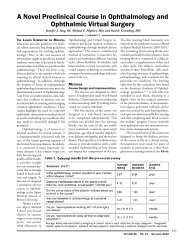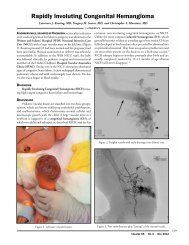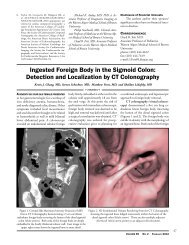16Military Blast Injury In Iraq and Afghanistan:<strong>The</strong> Veterans Health Administration’sPolytrauma System of CareStephen T. Mernoff, MD, FAAN, and Stephen Correia, PhD<strong>The</strong> proportion of veterans cared for bythe Veterans Health Administration(VHA) is rapidly shifting to those derivingfrom the Gulf War, which began in1990 and the Global War on Terror,which began in 2001. 1 <strong>The</strong> conflicts inAfghanistan (Operation Enduring Freedom,OEF) and Iraq (Operation IraqiFreedom, OIF), have produced1,016,213 veterans; and 454,121 ofthem have received care through theVHA as of the second quarter of 2009. 2As of July 31, 2009, 3980 US servicemembers have been killed and almost35,000 have been wounded in actionin OEF/OIF. 3 Explosive blasts haveaccounted for about 60% of these injuries.4,5 Other mechanisms of injury includeprojectiles (bullets, shrapnel), motorvehicle collisions, falls, and non-combat-relatedassaults. Service membersare surviving combat injuries at muchhigher rates than in past conflicts 5 anda high percentage of these individualshave traumatic brain injury (TBI),which has led to TBI’s label as the “signatureinjury” of OEF/OIF. 6 Estimatedrates of TBI in OEF/OIF reported inthe media vary widely with some beingalarmingly high. However, empiricalsupport for these estimates is limited dueto the small sample size, reliance on selfreportdata, use of data derived from asingle center, and restrictive inclusioncriteria. 5 Epidemiological data for injuriesin these conflicts continues to developbut a rigorous scientific study ofthe prevalence of TBI has not beendone. 5MEDICINE & HEALTH/RHODE ISLANDBLASTS, TBI, AND PTSD IN THEMILITARY POPULATIONBlasts are by far the most commoncause of wounded-in-action injuries anddeath in OEF/OIF. 5,6 <strong>The</strong> majority ofblasts are from improvised explosive devices.<strong>The</strong> most commonly involved organsystems include skin and muscle, skeletal,pulmonary, gastrointestinal, cardiovascular,vestibular, and neurological includingbrain, spinal cord, and peripheralnerves.<strong>The</strong> mechanisms by which blastscause TBI are unclear but likely arise froma combination of primary and secondaryeffects. <strong>The</strong> primary effect derives fromthe blast pressure wave. Evidence thatthese pressure waves can cause brain injuryderives from animal studies. 7,8 Secondaryeffects contributing to blast-relatedTBI include impact from projectileslaunched by the blast or from the victimstriking his or her head against theground or other stationary objects as aresult of the blast.<strong>The</strong> definition of mild TBI (mTBI)adopted by the VHA and Departmentof Defense (DOD) is based on the 1993American Congress of RehabilitationMedicine criteria:Mild traumatic brain injury isa traumatically-induced structuralinjury or physiologicaldisruption of brain functionresulting in one of the following:brief alteration in consciousness(dazed, disoriented,or confused), or loss of consciousness(LOC) of 30 minutesor less, or 24 hours or lessof posttraumatic amnesia(PTA, i.e., a loss of memory forthe period surrounding theevent that may occur with orwithout LOC).It is unknown whether the natureor prognosis of blast-related mTBI differsfrom other causes of mTBI. Recentdata suggest that the cognitive profiles ofpatients with blast-related vs. impact-relatedmTBI are similar. 9 Blast-relatedmTBI may have a stronger associationwith PTSD than other causes of mTBI. 5Recent studies have demonstrated a highrate of comorbidity with post traumaticstress disorder (PTSD). 10-12 As of thefirst quarter of 2009 approximately102,000 of OEF/OIF veterans havebeen diagnosed with PTSD. 2Postconcussive and PTSD symptomsoverlap considerably but not completely.13 Shared symptoms include depression/anxiety,insomnia, appetitechanges, irritability/anger, concentrationdifficulty, fatigue, hyperarousal, andavoidance. Symptoms more uniquely associatedwith persistent postconcussivesyndrome include headache, heightenedsensitivity to light and sound, dizzinessand disequilibrium, and memory impairment.Symptoms that are more uniqueto PTSD include re-experiencing,shame, and guilt. Nonetheless, accuratelyparsing the extent to which anindividual’s symptoms are attributed toPTSD vs. TBI is difficult, especially whenrelying on retrospective self-report of atemporally remote event. Many believethat it is more parsimonious and clinicallyuseful to conceptualize these symptomsas a single syndrome rather than two distinctentities. One term that has beenproposed is Combat-Related Brain Injuryand Stress Syndrome (David X. Cifu,personal communication, October2007). One of the authors (S.M.) hasused the term “Deployment-RelatedCognitive Impairment” to refer to thefrequent cognitive complaints of inattentionand forgetfulness. This term alignswell with previous findings of deployment-relatedneuropsychological deficitsin army personnel deployed in the Iraqwar. 14POLYTRAUMA SYSTEM OF CARE<strong>The</strong> rate of survival of combat injuriesin OEF/OIF, including TBI, is approximately90% 15 —considerably higher thanin previous conflicts. <strong>The</strong> high survival rateis due mainly to improvements in helmetand body armor and to improved deliveryof medical care including battlefield andin-theater hospital innovations. 5 This hasled to a high number of veterans with re-
habilitative needs. In response, the VHAestablished the Polytrauma Sytem of Carein 2004 with a mission “To ensure that theneeds of injured service members and Veteransare met.” 16 <strong>The</strong> VHA definespolytrauma as follows:“…two or more injuries sustainedin the same incident thataffect multiple body parts or organsystems and result in physical,cognitive, psychological, orpsychosocial impairments andfunctional disabilities. TBI frequentlyoccurs as part of thepolytrauma spectrum in combinationwith other disabling conditions,such as amputations,burns, pain, fractures, auditoryand visual impairments, PTSD,and other mental health conditions.When present, injury tothe brain is often the impairmentthat dictates the course of rehabilitationdue to the nature ofthe cognitive, emotional, and behavioraldeficits related toTBI.” 16<strong>The</strong> system is a hierarchy of facilitieswith particular roles:Polytrauma Rehabilitation <strong>Center</strong>s(PRC) provide acute high-intensityrehabilitative and medical care forthe seriously injured. <strong>The</strong>re are fourPRCs, located at <strong>VA</strong> <strong>Medical</strong> <strong>Center</strong>sin Tampa, FL; Richmond, <strong>VA</strong>;Minneapolis, MN; and Palo Alto,CA. A fifth center is under constructionat San Antonio, TX.Polytrauma Network Sites (PNS) providepost-acute inpatient and outpatientinterdisciplinary rehabilitativecare of moderate intensity formedically stable patients. Each ofVHA’s 22 Veterans Integrated ServiceNetworks (VISNs) has onePNS. <strong>The</strong> PNS for the New Englandregion (VISN-1) is the Boston<strong>VA</strong> Health Care System.Polytrauma Support Clinic Teams(PSCT) are interdisciplinary teamsthat manage medically stable outpatientswith an interdisciplinarytreatment plan. Patients are monitoredfor progress and the teamidentifies unresolved problems andimplements solutions. Eighty onePSCTs have been established nationally.Polytrauma Points of Contact (PPOC)are staff members at all remaining<strong>VA</strong> facilities who assist veterans inaccessing the Polytrauma system.Patients can be referred up or downthe hierarchy in accordance with theirmedical needs and the services providedat the various facilities.POLYTRAUMA SYSTEM: SCREENINGFOR TBIVHA Directive 2007-13 establishedscreening of all service members returningfrom deployment in OEF/OIF todetermine if they had possibly sustaineda deployment-related traumatic braininjury that had not already been diagnosed.In response, the <strong>VA</strong> PolytraumaProgram developed a standard, two-tierscreening process implemented nationally.<strong>The</strong> data collected is entered into the<strong>VA</strong>’s electronic medical record system andis tracked nationally.<strong>The</strong> initial screen, called the “TBIClinical Reminder,” is required for allOEF/OIF veterans who enter the <strong>VA</strong>health care system. <strong>The</strong> Reminder consistsof a set of yes-no questions organizedinto four sections that determine whetheror not the veteran experienced the following:exposure to a deployment-relatedevent with risk for TBI; acute alterationof consciousness; postconcussive symptomsduring the immediate post-acutephase; persistence of such symptoms currently.A positive screen is defined as anaffirmative response to all four sections;a negative response to any section resultsin a negative screen. <strong>The</strong> reliability andvalidity of the screen have not been established,and is under research investigation.Veterans who screen positive are referredfor a “Comprehensive Second-Level Evaluation” which consists of a standard,more detailed assessment of TBI.It is intended to determine more accuratelythe likelihood that a veteran sustaineda TBI and to estimate the severityof the injury. It also assesses symptoms,elicits clinicians’ opinions about the likelihoodthat the symptoms reflect the effectsof TBI and/or other factors (e.g., psychiatricdisorder), and establishes a treatmentplan. At most <strong>VA</strong> facilities, the“Second-Level Evaluation” is performedby a “TBI specialist,” typically a physiatristor neurologist, who leads thepolytrauma team at that facility.Except in relatively rare cases inwhich documentation is available, theinitial screen and the Second-Level Evaluationtypically rely on patients’ recall oftheir injuries. This is an important limitationto the system because retrospectiveself-report of an event or events thatoccurred many months or years earliermay be unreliable. Moreover, the intenseemotional reaction to the chaotic eventof a blast may well acutely and transientlyalter cognitive function which couldmasquerade as TBI or enhance its effectsand it can be very difficult teasing thesefactors apart. At the P<strong>VA</strong>MC, we haveadopted a fairly parsimonious clinicalguideline for determining the presenceof absence of TBI: a patient who can relatea continuous narrative before/during/afteran event seems unlikely to havesuffered a physiologic disruption of brainfunction. We have found this guidelineto be quite helpful in ambiguous casesbut its reliability and validity have notbeen determined.DIAGNOSIS OF TBI IN THEPOLYTRAUMA SYSTEMNational Experience (data roundedoff to nearest 1000):<strong>The</strong> TBI Clinical Reminder wasimplemented in April 2007. ThroughMay 31, 2009, 316,000 veterans havecompleted the Clinical Reminder;63,000 (20%) screened “positive” forpossible TBI. Of these, 41,000 completedthe Comprehensive Second-Level Evaluationwhich confirmed the mTBI diagnosisin 20,000 (49%). This estimate doesnot include an additional 9440 veteranswho self-reported having been previouslydiagnosed with TBI during their deployment.<strong>The</strong>re is considerable variabilityacross <strong>VA</strong> <strong>Medical</strong> <strong>Center</strong>s in the rateat which mTBI is diagnosed by this process.Potential reasons include variabilityin the combat roles of military unitsbased in different geographical regionsof the U.S. (some combat roles carryVOLUME 93 NO. 1 JANUARY 201017
















